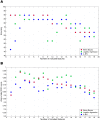Machine learning approach for the outcome prediction of temporal lobe epilepsy surgery
- PMID: 23646148
- PMCID: PMC3640010
- DOI: 10.1371/journal.pone.0062819
Machine learning approach for the outcome prediction of temporal lobe epilepsy surgery
Abstract
Epilepsy surgery is effective in reducing both the number and frequency of seizures, particularly in temporal lobe epilepsy (TLE). Nevertheless, a significant proportion of these patients continue suffering seizures after surgery. Here we used a machine learning approach to predict the outcome of epilepsy surgery based on supervised classification data mining taking into account not only the common clinical variables, but also pathological and neuropsychological evaluations. We have generated models capable of predicting whether a patient with TLE secondary to hippocampal sclerosis will fully recover from epilepsy or not. The machine learning analysis revealed that outcome could be predicted with an estimated accuracy of almost 90% using some clinical and neuropsychological features. Importantly, not all the features were needed to perform the prediction; some of them proved to be irrelevant to the prognosis. Personality style was found to be one of the key features to predict the outcome. Although we examined relatively few cases, findings were verified across all data, showing that the machine learning approach described in the present study may be a powerful method. Since neuropsychological assessment of epileptic patients is a standard protocol in the pre-surgical evaluation, we propose to include these specific psychological tests and machine learning tools to improve the selection of candidates for epilepsy surgery.
Conflict of interest statement
Figures


References
-
- Falconer MA (1974) Mesial temporal Ammon's horn. sclerosis as a common cause of epilepsy. Aetiology, treatment, and prevention. Lancet 2 767–770. - PubMed
-
- Engel J Jr (1993) Historical perspectives and future directions. In: Wyllie E, editors. The Treatment of Epilepsy, Principle and Practice. Philadelphia: Lea & Febiger. 989–998.
-
- Wieser HG, Engel J Jr, Williamson PD, Babb TL, Gloor P (1993) Surgically remediable temporal lobe syndromes. In: Engel JJr, editors. Surgical treatment of epilepsies. New York: Raven Press. 49–63.
-
- Meldrum BS, Bruton CJ, Adams J, Duchen LW (1992) Epilepsy. In: Graham DI, Lantos PL, editors. Greenfield's Neuropathology. London: Arnold. 1246–1283.
-
- Honavar M, Meldrum BS, Graham DI, Lantos PL (1997) Epilepsy. In: Graham DI, Lantos PL, editors. Greenfield's Neuropathology. London: Arnold. 931–971.
Publication types
MeSH terms
LinkOut - more resources
Full Text Sources
Other Literature Sources

